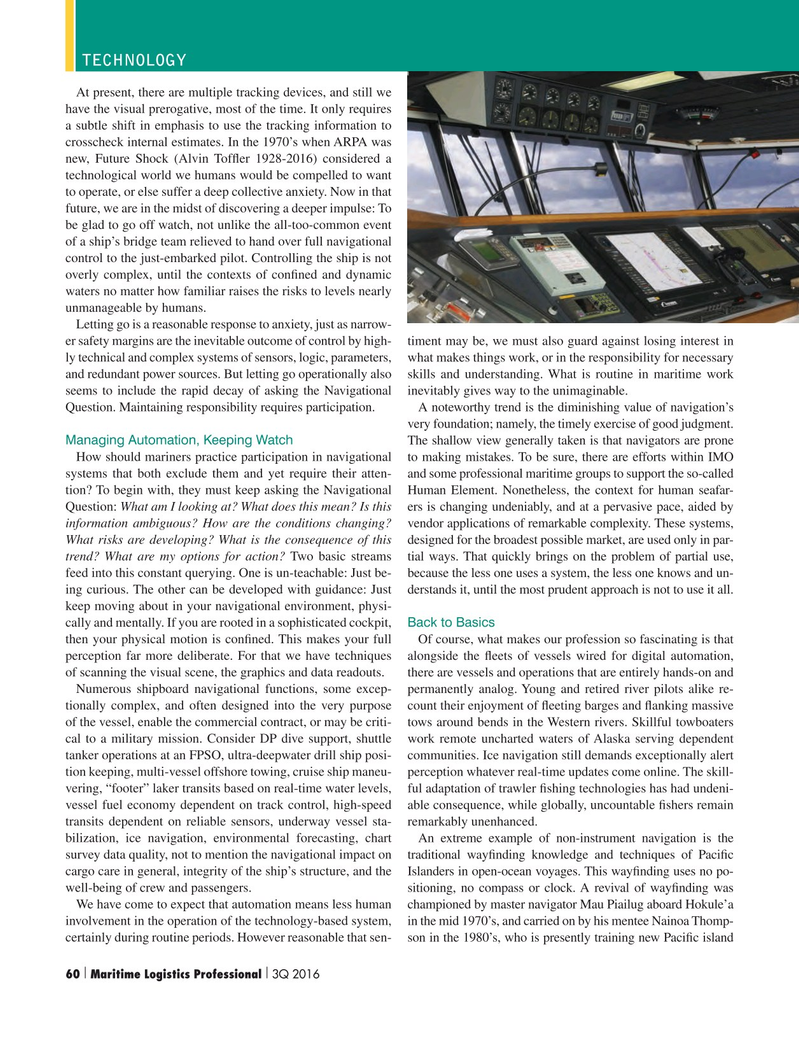
Page 60: of Maritime Logistics Professional Magazine (Q3 2016)
Shipbuilding, Repair & Maintenance
Read this page in Pdf, Flash or Html5 edition of Q3 2016 Maritime Logistics Professional Magazine
TECHNOLOGY
At present, there are multiple tracking devices, and still we have the visual prerogative, most of the time. It only requires a subtle shift in emphasis to use the tracking information to crosscheck internal estimates. In the 1970’s when ARPA was new, Future Shock (Alvin Tof? er 1928-2016) considered a technological world we humans would be compelled to want to operate, or else suffer a deep collective anxiety. Now in that future, we are in the midst of discovering a deeper impulse: To be glad to go off watch, not unlike the all-too-common event of a ship’s bridge team relieved to hand over full navigational control to the just-embarked pilot. Controlling the ship is not overly complex, until the contexts of con? ned and dynamic waters no matter how familiar raises the risks to levels nearly unmanageable by humans.
Letting go is a reasonable response to anxiety, just as narrow- er safety margins are the inevitable outcome of control by high- timent may be, we must also guard against losing interest in ly technical and complex systems of sensors, logic, parameters, what makes things work, or in the responsibility for necessary and redundant power sources. But letting go operationally also skills and understanding. What is routine in maritime work seems to include the rapid decay of asking the Navigational inevitably gives way to the unimaginable.
Question. Maintaining responsibility requires participation. A noteworthy trend is the diminishing value of navigation’s very foundation; namely, the timely exercise of good judgment.
Managing Automation, Keeping Watch The shallow view generally taken is that navigators are prone
How should mariners practice participation in navigational to making mistakes. To be sure, there are efforts within IMO systems that both exclude them and yet require their atten- and some professional maritime groups to support the so-called tion? To begin with, they must keep asking the Navigational Human Element. Nonetheless, the context for human seafar-
Question: What am I looking at? What does this mean? Is this ers is changing undeniably, and at a pervasive pace, aided by information ambiguous? How are the conditions changing? vendor applications of remarkable complexity. These systems,
What risks are developing? What is the consequence of this designed for the broadest possible market, are used only in par- trend? What are my options for action? Two basic streams tial ways. That quickly brings on the problem of partial use, feed into this constant querying. One is un-teachable: Just be- because the less one uses a system, the less one knows and un- ing curious. The other can be developed with guidance: Just derstands it, until the most prudent approach is not to use it all.
keep moving about in your navigational environment, physi- cally and mentally. If you are rooted in a sophisticated cockpit, Back to Basics then your physical motion is con? ned. This makes your full Of course, what makes our profession so fascinating is that perception far more deliberate. For that we have techniques alongside the ? eets of vessels wired for digital automation, of scanning the visual scene, the graphics and data readouts. there are vessels and operations that are entirely hands-on and
Numerous shipboard navigational functions, some excep- permanently analog. Young and retired river pilots alike re- tionally complex, and often designed into the very purpose count their enjoyment of ? eeting barges and ? anking massive of the vessel, enable the commercial contract, or may be criti- tows around bends in the Western rivers. Skillful towboaters cal to a military mission. Consider DP dive support, shuttle work remote uncharted waters of Alaska serving dependent tanker operations at an FPSO, ultra-deepwater drill ship posi- communities. Ice navigation still demands exceptionally alert tion keeping, multi-vessel offshore towing, cruise ship maneu- perception whatever real-time updates come online. The skill- vering, “footer” laker transits based on real-time water levels, ful adaptation of trawler ? shing technologies has had undeni- vessel fuel economy dependent on track control, high-speed able consequence, while globally, uncountable ? shers remain transits dependent on reliable sensors, underway vessel sta- remarkably unenhanced. bilization, ice navigation, environmental forecasting, chart An extreme example of non-instrument navigation is the survey data quality, not to mention the navigational impact on traditional way? nding knowledge and techniques of Paci? c cargo care in general, integrity of the ship’s structure, and the Islanders in open-ocean voyages. This way? nding uses no po- well-being of crew and passengers. sitioning, no compass or clock. A revival of way? nding was
We have come to expect that automation means less human championed by master navigator Mau Piailug aboard Hokule’a involvement in the operation of the technology-based system, in the mid 1970’s, and carried on by his mentee Nainoa Thomp- certainly during routine periods. However reasonable that sen- son in the 1980’s, who is presently training new Paci? c island 60 Maritime Logistics Professional 3Q 2016| | 50-63 Q3 MP2016.indd 60 8/17/2016 10:29:35 AM

 59
59

 61
61
